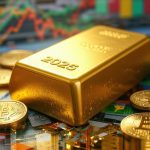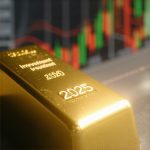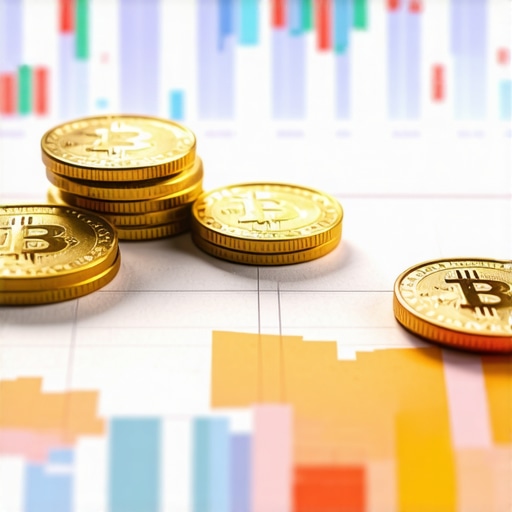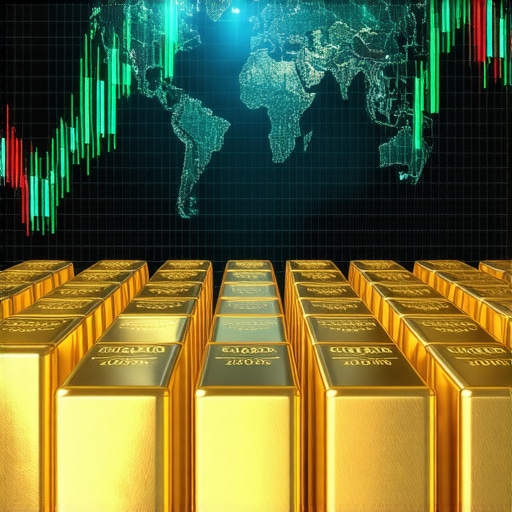Understanding the Nexus Between Global Economic Factors and Gold Price Trajectories
The intricate relationship between macroeconomic forces and gold prices is a subject of perennial importance for sophisticated investors and financial analysts. As we venture into 2025, a confluence of geopolitical uncertainties, monetary policy shifts, and technological advancements continues to shape the valuation of gold as a pivotal asset class. Recognizing the underlying mechanisms driving these correlations empowers stakeholders to refine their investment strategies in a landscape marked by volatility and emerging opportunities.
Macro Drivers of Gold Valuation: An Expert-Level Perspective
How Do Central Bank Policies and Gold Reserves Influence Price Dynamics?
Central banks’ accumulation or divestment of gold reserves exerts a profound influence on market sentiment and price levels. Notably, aggressive gold purchases by major economies serve as a hedge against fiat currency depreciation, especially amid rising inflationary pressures. The interplay between quantitative easing measures and gold holdings underscores a strategic shift toward tangible assets during periods of monetary expansion, a trend anticipated to persist into 2025 and beyond. For an in-depth analysis, see this comprehensive review.
Geopolitical Tensions and Their Amplification of Gold’s Safe-Haven Status
Escalating geopolitical conflicts and trade tensions often lead to heightened demand for secure assets like gold. This relationship is reinforced by the realization that gold functions effectively as a store of value during periods of economic instability. As global supply chains face disruptions and international relations become more volatile, the demand-supply dynamics of gold are poised for significant shifts, influencing prices well into the next decade.
Inflation, Deflation, and the Role of Real Interest Rates
Economic indicators such as inflation rates and real interest rates are pivotal in determining gold’s attractiveness. When real interest rates decline, the opportunity cost of holding non-yielding assets like gold diminishes, encouraging increased investment. Conversely, rising nominal interest rates can suppress gold prices by boosting yields elsewhere. This nuanced relationship is crucial for investors aiming to hedge against inflationary spirals anticipated in the post-pandemic economic recovery phase.
What Are the Underlying Complexities That Make Gold Prices a Multifaceted Indicator?
Beyond traditional macroeconomic factors, gold prices are affected by emerging trends such as technological innovations in mining, environmental policies, and shifts in consumer sentiment. These elements add layers of complexity, requiring investors to adopt a holistic approach that integrates fundamental analysis with sentiment and technical indicators. The ongoing evolution of these factors necessitates continuous monitoring and adaptive strategies.
For those interested in diversifying portfolios with gold, exploring gold IRAs and retirement strategies can be especially beneficial. Additionally, leveraging gold ETFs and mutual funds presents a flexible means of exposure, aligning with evolving market conditions.
How Can Investors Navigate the Uncertainties of Future Market Movements?
Given the multifaceted influences on gold prices, employing advanced trading techniques and market analysis tools is essential. Techniques such as effective gold trading strategies for market volatility, outlined here, are designed to optimize returns amid unpredictable swings. Moreover, maintaining an awareness of global economic indicators and policy shifts can significantly enhance decision-making accuracy.
As the landscape of global economic influences continues to evolve, engaging with expert insights and detailed analyses remains critical. For further exploration of gold market forecasts, consult this authoritative source.
Interested readers are encouraged to contribute their insights or explore related topics such as gold versus stocks in 2025 for a comprehensive investment outlook.
Deciphering the Impact of Emerging Technologies and Environmental Policies on Gold Markets
As we advance further into 2025, technological innovations in mining and refining processes are reshaping the supply landscape of gold. Automation, AI-driven exploration, and environmentally sustainable practices not only influence production costs but also affect the overall supply-demand dynamics. Meanwhile, stricter environmental policies in major mining countries can constrain supply chains, potentially driving prices upward. These factors add a layer of complexity to traditional macroeconomic analysis, urging investors to incorporate insights from industry experts and environmental reports.
How Do Shifts in Consumer Sentiment and Digital Asset Competition Reshape Gold’s Safe-Haven Status?
Consumer sentiment, driven by geopolitical stability and economic outlooks, continues to be a significant driver of gold demand. However, the rising popularity of digital assets, especially cryptocurrencies, introduces new competition. While gold remains a tangible store of value, the perception of digital assets as alternative hedges influences investment allocations. Analyzing these sentiment shifts requires a nuanced understanding of investor psychology and macroeconomic trends, which can be supported by tools like sentiment analysis algorithms and market surveys.
Expert Strategies for Sophisticated Investors: How Can Advanced Market Analysis Enhance Gold Investment Returns?
Employing sophisticated analysis techniques—such as quantitative modeling, machine learning predictions, and technical pattern recognition—can provide a strategic edge in navigating volatile markets. For instance, leveraging effective gold trading techniques allows for better timing and risk management. Additionally, integrating macroeconomic indicators like inflation expectations and real interest rate trajectories with technical signals can optimize entry and exit points for gold positions.
What are the emerging indicators that could signal major price shifts in gold during 2025?
Investors should monitor a combination of geopolitical developments, central bank policies, and technological breakthroughs to anticipate price movements. For example, sudden changes in central bank gold reserves, driven by geopolitical tensions or monetary policy shifts, can act as early warning signals. Similarly, advancements in blockchain-based tracking systems for gold supply chains could impact transparency and investor confidence. Staying informed through reputable sources such as this detailed analysis can help investors adapt to these evolving indicators.
Consider engaging with community discussions or sharing your insights on market trends to deepen your understanding and refine your strategies. For more expert-guided approaches, explore tips for safe gold investing in 2025.
Decoding the Interplay of Emerging Technologies and Policy Shifts in Gold Markets
As the gold market evolves in 2025, technological innovations such as blockchain-based supply chain tracking and AI-driven exploration are transforming the transparency, efficiency, and sustainability of gold mining and trading. These advances not only influence production costs but also reshape investor perceptions of gold’s reliability and liquidity. For instance, companies employing environmentally sustainable practices are gaining favor among socially conscious investors, potentially impacting supply-demand balances and price stability. The integration of environmental policies, especially in major mining nations like South Africa and Australia, can further constrict or expand supply channels, adding another layer of complexity to price forecasts.
According to a 2024 report by the World Gold Council, environmental regulations combined with technological advancements are expected to create a nuanced landscape where supply constraints may lead to upward price pressures, especially if demand remains robust from institutional investors or central banks.
How Do Consumer Sentiment and Digital Asset Competition Reshape Gold’s Safe-Haven Status?
Investor psychology plays a pivotal role in gold price movements. During times of geopolitical tension or economic uncertainty, gold’s reputation as a safe-haven asset is reinforced. However, the rise of digital assets, notably cryptocurrencies like Bitcoin, introduces a new dimension to hedging strategies. These digital assets are often perceived as alternative stores of value, especially among younger or tech-savvy investors, which can divert capital away from traditional gold investments. Nonetheless, gold’s tangible nature, historical stability, and liquidity continue to underpin its safe-haven appeal, especially when digital assets face regulatory scrutiny or technological vulnerabilities.
Market surveys from 2024 indicate that while cryptocurrencies are gaining traction, a significant portion of institutional investors still favor gold for portfolio diversification and risk mitigation. This dynamic underscores the importance of nuanced analysis tools, such as sentiment analysis algorithms and macroeconomic modeling, to anticipate shifts in investor allocations.
Expert Strategies: Leveraging Advanced Market Analysis for Superior Gold Investment Outcomes
In an environment characterized by volatility and rapid technological change, traditional analysis techniques must be supplemented with cutting-edge tools. Quantitative modeling, machine learning algorithms for pattern recognition, and real-time data feeds enable investors to identify subtle market signals that precede major price movements. For example, predictive analytics can flag potential supply shocks stemming from geopolitical developments or regulatory shifts, providing a strategic edge.
For instance, a recent study published in the Journal of Financial Markets highlights how machine learning models incorporating macroeconomic indicators, such as inflation expectations and real interest rate trajectories, outperform conventional methods in predicting short-term gold price shifts. Incorporating these insights into a comprehensive risk management framework allows investors to optimize entry and exit points, reducing exposure during turbulent periods and capitalizing on emerging opportunities.
What Are the Key Indicators Signaling Major Price Shifts in Gold During 2025?
Investors should closely monitor a combination of geopolitical developments, central bank reserve adjustments, and technological innovations. Sudden increases in central bank gold holdings, especially if coordinated across multiple nations, can signal a strategic shift with potential price implications. Additionally, advancements in blockchain transparency for gold supply chains may influence investor confidence, either reinforcing trust or highlighting vulnerabilities.
For a detailed analysis on these indicators, consult resources like the World Gold Council’s latest reports or specialized market analytics platforms that track real-time reserve data and technological trends. Staying ahead of these signals requires continuous learning and adaptive strategies, which can be facilitated through expert-led webinars and industry conferences.
If you are committed to refining your gold investment approach in 2025, engaging with advanced analytical tools and expert insights is crucial. Explore our comprehensive guides and subscribe for updates to stay informed on the latest market developments.
Decoding the Interplay of Technological Innovation and Geopolitical Strategies in Gold Markets
As we delve deeper into 2025, the integration of cutting-edge technologies such as blockchain for supply chain transparency and AI-driven exploration techniques is revolutionizing gold’s supply dynamics. These innovations not only enhance operational efficiency but also influence investor perceptions of gold’s legitimacy and liquidity. Moreover, geopolitical strategies, including international sanctions and trade agreements, can significantly alter the flow of gold across borders, impacting global prices. Industry reports from the World Gold Council highlight that countries adopting environmentally sustainable mining practices are increasingly favored, which could lead to shifts in supply availability and pricing stability.
The Role of Digital Currencies and Regulatory Environments in Shaping Gold’s Safe-Haven Appeal
In 2025, the competition between traditional safe-haven assets like gold and emerging digital currencies remains intense. Cryptocurrencies such as Bitcoin are perceived as alternative hedges, especially among younger investors, but regulatory uncertainties often hinder their widespread acceptance. Conversely, gold’s tangible nature and historical resilience continue to underpin its safe-haven status. According to a 2024 analysis by the International Monetary Fund, evolving regulatory frameworks around digital assets could either bolster or diminish their role as hedges, indirectly influencing gold’s demand and pricing.
What Are the Sophisticated Indicators That Signal Major Price Movements in Gold During 2025?
Investors seeking to stay ahead must monitor an array of complex signals, including shifts in central bank reserve allocations, geopolitical flashpoints, technological breakthroughs in mining, and regulatory developments in digital assets. Sudden increases in central bank gold reserves, especially coordinated movements, often presage bullish trends. Additionally, breakthroughs in blockchain transparency for gold trading can bolster investor confidence or reveal vulnerabilities, influencing prices. Keeping abreast of real-time reserve data and technological advancements through platforms like the World Gold Council’s latest reports is essential for proactive decision-making.
Engaging with expert analysis and leveraging advanced predictive models—such as machine learning algorithms that incorporate macroeconomic variables—can provide a strategic edge. For instance, models that synthesize inflation expectations, real interest rates, and geopolitical risk indices outperform traditional forecasting methods in capturing short-term price shifts.
How Can Investors Optimize Gold Portfolio Strategies Amid Market Uncertainties in 2025?
Effective diversification into gold assets, including physical coins and bars, ETFs, and innovative financial instruments like gold-linked derivatives, is fundamental. Employing dynamic risk management tools, such as volatility-adjusted position sizing and real-time market monitoring, allows investors to capitalize on emerging opportunities while mitigating downside risks. Furthermore, integrating insights from geopolitical risk assessments and technological developments into portfolio rebalancing strategies enhances resilience against unpredictable market shocks.
Explore advanced analytical tools and stay connected with industry thought leaders by subscribing to expert newsletters and participating in specialized webinars. These resources provide actionable insights to refine your investment approach in this complex environment.
Expert Insights & Advanced Considerations
1. Geopolitical Stability as a Catalyst for Gold Demand
Geopolitical tensions remain a pivotal factor influencing gold prices. Experts observe that rising conflicts and trade disputes tend to drive safe-haven demand, reinforcing gold’s role as a portfolio hedge during turbulent times. Monitoring international relations and conflict zones provides strategic entry points for sophisticated investors seeking to capitalize on market shifts.
2. Technological Innovations Reshaping Supply Chains
Advancements such as blockchain-enabled supply chain transparency and AI-driven exploration are transforming gold mining and trading. These innovations enhance market confidence and can lead to tighter supply, potentially elevating prices. Staying abreast of technological developments and environmental policies is crucial for anticipating supply-demand dynamics.
3. Digital Assets and Gold Competition
The rise of cryptocurrencies offers alternative hedging options, challenging gold’s traditional safe-haven status. However, regulatory uncertainty and digital asset volatility often reinforce gold’s tangible value. Expert analysis suggests a diversified approach, integrating both assets to optimize risk-adjusted returns.
4. Central Bank Reserves as Price Indicators
Central banks’ gold reserve policies serve as critical indicators. Strategic accumulation or divestment signals can precede major price movements. Investors focused on macro trends should analyze reserve data releases and policy statements for predictive insights.
5. Advanced Market Analysis Techniques
Employing machine learning models, macroeconomic simulations, and sentiment analysis offers a competitive edge. These tools help forecast short-term fluctuations and long-term trends, essential for navigating 2025’s complex market environment.
Curated Expert Resources
- World Gold Council Reports: Comprehensive insights into global supply-demand trends and policy impacts, crucial for strategic planning.
- Financial Times Market Analysis: Expert commentary on geopolitical developments and technological trends affecting gold markets.
- Academic Journals on Market Prediction Models: Cutting-edge research on machine learning applications for financial forecasting.
- Industry Conferences and Webinars: Opportunities for real-time expert discussions on emerging trends and policy shifts.
- Official Reserve Data Platforms: Real-time updates on central bank gold holdings and movements for proactive decision-making.
Final Expert Perspective
In 2025, understanding the intricate interplay of geopolitical stability, technological innovation, and macroeconomic policies is essential for mastering gold investment strategies. The convergence of these factors underscores gold’s enduring significance as a safe haven and strategic asset. For investors committed to excellence, integrating advanced analytical tools and authoritative resources will be key to navigating the evolving landscape and achieving superior outcomes. Engage with industry thought leaders, contribute your insights, and continually refine your approach to stay ahead in the dynamic world of gold investments.









